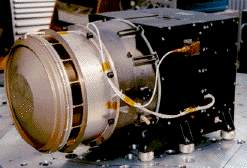
The Composition and Distribution Function (CODIF) Analyzer

|
| CODIF sensor. Particles can enter through the aperture all around the front end of the cylindrical section of the instrument. |
CODIF measures the 3D distribution functions of the major ion species, H, He+, He++, and O+. It consists of a toroidal energy-per-charge (E/q) analyzer with a disk-shaped field of view, followed by a 20 kV post-acceleration into a time-of-flight (TOF) analysis section. The E/q range is 15 V to 40 kV. An optional retarding potential analyzer in the entrance aperture allows the energy range to be extended down to essentially zero volts. To accommodate the large dynamic range in ion fluxes, the instrument has split the 360 deg. FoV into two 180 deg. sections whose sensitivities differ by a factor of 100. Moments of the distribution of all 4 ion species are computed onboard and are available every spin, i.e., every 4 seconds. (You will find a flow chart of its principles of operation here.) The instrument is identical to the ESIC instrument on Equator-S.
Pictures of CODIF are available, from both before and after the explosion.
Link to: Cluster CIS Server (France)
The COmposition and DIstribution Function Analyzer (CODIF) determines the species as well as the energy and directional distribution of incoming ions. It employs an Electrostatic Analyzer to measure the energy/charge and Time-of-Flight measurement to derive the energy/mass of the ions. It scans the full sky in one revolution of the spacecraft (~ 5 seconds).
CODIF is one sensor of the Cluster Ion Spectrometry (CIS) experiment that was developed by scientists from France, Germany, the US, Italy, Switzerland and Sweden under the direction of H. Rème from the Centre d`Etude Spatiale et Rayonnement, Toulouse, France. The UNH contribution is the time-of-flight section of the sensor and its calibration.
The Time-of-Flight spectrum from calibrations at the facility of the University of Bern, Switzerland, shows how different species are separated by the instrument.
To learn more, read the instrument description paper, or watch the Time of Flight Detector Movie